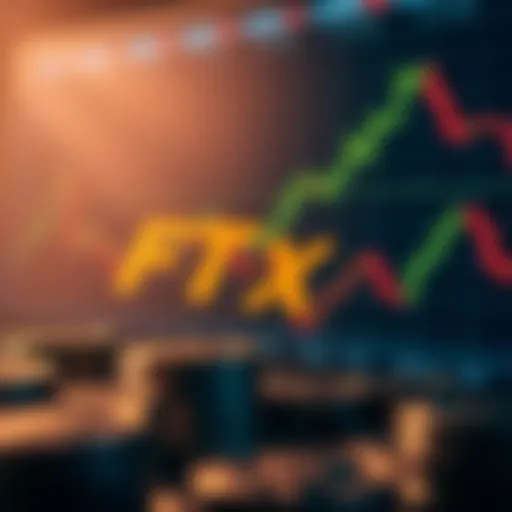Understanding USD Converters in Cryptocurrency Market


Intro
In recent years, the world of cryptocurrency has taken off at remarkable speed. With Bitcoin’s phenomenal rise, inspired a multitude of virtual currencies, many folks are eager to jump on the bandwagon. But as is often the case, understanding the nitty-gritty of these digital coins can feel like trying to nail jelly to a wall. A crucial aspect of this cryptocurrency journey is figuring out how to convert your good ol' USD into these digital assets and back again smoothly. This article dives into how USD converters operate in the cryptocurrency realm, their importance, and what they mean for market behavior.
Navigating this space entails understanding not just the conversion tools, but also the broader principles that govern cryptocurrencies. Let’s kick things off by shedding light on some fundamental concepts.
Understanding Cryptocurrency Concepts
Blockchain Technology Explained
At the heart of cryptocurrency lies blockchain technology. Imagine a digital ledger that records every single transaction happening across a network, stored securely and transparently. That’s what blockchain is, essentially. Each transaction is grouped in a block, and these blocks are linked in a chronologically ordered chain.
This technology ensures that no single entity holds the reins; instead, the power is distributed across a network. For investors, this means enhanced security and reduced chances of fraud. However, it also brings challenges when it comes to transaction speed and scalability, especially during times of high demand.
Key Terms Every Investor Should Know
To effectively navigate the crypto world, there are some key terms that one should familiarize themselves with. Here’s a short rundown:
- Altcoin: Any cryptocurrency that isn’t Bitcoin.
- Wallet: A digital place to store cryptocurrencies.
- ICO (Initial Coin Offering): A method for blockchain projects to raise funds, akin to an IPO.
- Market Cap: The total value of a cryptocurrency, calculated by multiplying the current price by the total supply.
Understanding these terms can aid investors in making informed decisions, especially when utilizing converters to exchange USD for crypto.
Market Analysis and Trends
Current Market Trends in Cryptocurrency
The crypto market is dynamic and ever-evolving. One trend that’s gaining traction is the growing interest in decentralized finance (DeFi), where traditional financial services are rebuilt on blockchain. This allows for lending, borrowing, and trading without intermediaries.
Moreover, institutional investment has witnessed a significant uptick, with large corporations and hedge funds diving in. This interest tends to affect market confidence and, consequently, conversion rates.
Investment Strategies for Different Market Conditions
Investing in cryptocurrencies isn't a straightforward affair. Market volatility can be a double-edged sword, offering both risks and opportunities. Here are a few strategies to consider:
- Dollar-Cost Averaging: Investing a fixed amount regularly can help mitigate the impact of volatility.
- Hedging: Using financial instruments or market strategies to offset potential losses can protect investments during downturns.
- Stay Informed: Regularly following market news and trends is crucial. Resources like Wikipedia or Britannica can provide valuable insights.
"Volatility in cryptocurrency markets is both a challenge and an opportunity for investors. Understanding how to manage it can make a lasting difference in portfolio performance."
In summary, grasping the essential concepts of cryptocurrency and staying abreast of market trends is vital for successful navigation of the USD converter landscape. As this digital economy continues to blossom, being equipped with knowledge can make all the difference in decision-making and maximizing investment strategies.
Understanding USD Converters
In the world of cryptocurrency, USD converters hold a pivotal role akin to a compass for investors, allowing them to navigate the sometimes turbulent financial waters with better clarity. These tools don't just serve as a bridge between fiat currencies and cryptocurrencies; they represent a crucial aspect of financial strategy and real-time decision-making in trading. From day-to-day transactions to strategic investments, a thorough comprehension of USD converters is essential for both novice and experienced traders.
Definition and Purpose
At its core, a USD converter is a tool designed to help users exchange United States dollars for various cryptocurrencies like Bitcoin or Ethereum, and vice versa. In simple terms, it’s like an online marketplace where you can easily swap one currency for another without much hassle.
The purpose of these converters extends beyond mere transactions. They function to provide real-time exchange rates, which are essential for making informed trading decisions. When an investor sees a favorable exchange rate, they can act quickly, potentially capitalizing on market fluctuations and maximizing their investment returns.
- Ease of Use: Most converters are user-friendly, requiring little more than inputting the amount and hitting a button to see results.
- Accessibility: Users can access these converters from virtually anywhere, giving them the freedom to make transactions on-the-go.
- Decision Making: Accurate and current rates can greatly influence trading strategies, allowing investors to time their trades effectively.
Historical Context
Understanding the evolution of USD converters provides valuable insights into their significance today. In the early days of cryptocurrency, the market was less defined, and only a handful of platforms existed to facilitate exchanges. For instance, Bitcoin's launch in 2009 marked the beginning of a new financial era, but it took time before conversion tools became widely accessible and trusted.
Back then, most exchanges offered minimal information about conversion rates, leading to confusion and mistrust. As the cryptocurrency ecosystem evolved, so did the sophistication of USD converters. The introduction of blockchain technology paved the way for safer, more transparent transactions. Furthermore, with the rise of platforms like Coinbase and Binance in the mid-2010s, users began experiencing quicker, more reliable conversions.
Today, the landscape is bustling with multiple offerings that include desktop applications, mobile apps, and even wallet integrations. These advancements not only reflect the growth of the digital currency market but also underscore the increasing importance of accurate exchange rates in crafting successful investment strategies. Understanding how we arrived here helps us gauge where we might be headed in the vast universe of digital currencies.
Market Dynamics Influencing Conversion Rates
Understanding how market dynamics influence conversion rates is key for anyone dabbling in cryptocurrencies. In a space that’s notoriously volatile, the elements affecting these rates can vary widely, which in turn impacts both individual and institutional investors. Being aware of these dynamics can help investors time their transactions more effectively and avoid unexpected losses.
Supply and Demand Factors


At its core, the concept of supply and demand drives any market, including that of cryptocurrency and USD conversion. When there's a high demand for a specific cryptocurrency, yet its supply remains limited, prices tend to surge. Conversely, if a cryptocurrency is readily available and demand wanes, the price will likely plummet.
For example, during times of market euphoria, like the huge highs during late 2017 and early 2021, investors flocked to Bitcoin and Ethereum, pushing prices up significantly due to heightened demand. The inverse occurs as market sentiments shift, with liquidity draining from the market when people lose faith, thus dwindling demand leads to reduced prices.
To illustrate: if a major tech company announces it will begin accepting Bitcoin for transactions, this can lead to a sudden spike in demand, thereby affecting conversion rates noticeably. The strategic use of USD converters becomes vital here. Investors must pay attention to volume metrics, as higher trading volumes often correlate with more stable prices, making it easier to convert USD to cryptocurrencies without facing heavy slippage.
Geopolitical Influences
Geopolitical events can cast long shadows on cryptocurrency conversion rates. Regulatory announcements, shifts in political stability, and even cultural trends play a significant role in shaping the landscape. For example, if a government suddenly decides to regulate cryptocurrencies more strictly, it can lead to fear and uncertainty, resulting in a rush to sell, thus affecting conversion rates.
China's ban on cryptocurrency exchanges in 2017 not only led to a crash in Bitcoin prices but also shifted global trading patterns. Countries with more favorable regulations, such as El Salvador's adoption of Bitcoin as legal tender, can significantly encourage demand, affecting how conversions between USD and Bitcoin take place.
Essentially, an investor must always keep an eye on news alerts and global events. The interplay between local regulations and international sentiment often operates like a swirling tide, influencing traders’ decisions on when it’s time to convert their funds. This fluidity makes a clear understanding of these factors not just useful, but essential for those navigating the USD converter landscape in crypto.
Key Features of USD Converters
Understanding the key features of USD converters is paramount for anyone looking to navigate the often-choppy waters of cryptocurrency conversion. In a field that’s rapidly evolving, these features provide clarity and usability, making it easier for investors, traders, and enthusiasts alike to make informed decisions.
At the core, effective USD converters enable users to accurately gauge conversion values and timely transactions, ensuring that they’re not left behind as market dynamics shift. Given the significance of swift and precise transactions in the digital currency arena, the next two sections will delve into the standout characteristics that set the top converters apart from the rest.
Real-Time Data Processing
Real-time data processing stands as a cornerstone of effective USD converters. With prices fluctuating at breakneck speeds, having instant access to accurate exchange rates is non-negotiable. Just imagine trying to make a trade: if you're not equipped with live updates, you might end up missing the boat.
In substance, these converters harness APIs, which regularly pull data from various exchanges and aggregators. This means that users experience up-to-the-minute rates, allowing for informed decision-making. Rumors and speculation can quickly sway opinion in the crypto market, so utilizing converters that provide up-to-the-second data becomes essential.
To illustrate this, consider the example of a trader. If you’re looking to convert Bitcoin to USD while the market is peaking, but rely on outdated rates, that can lead to significant financial losses. Anticipation of the best price in real-time can be the difference between profit and ruin.
User Interface and Accessibility
The user interface and accessibility are additional key features that cannot be overlooked, especially for those who might be dipping their toes into cryptocurrency for the first time. A well-designed interface reduces the barrier to entry, fostering not only adoption but also frequent engagement from a broader user base.
Simple and intuitive navigation is crucial; users should not be grappling with complicated layouts when attempting to convert funds. Accessibility is also about adaptive design—being mobile-friendly is no longer a luxury but a necessity. Many users, especially those familiar with their smartphones, expect to conduct transactions on-the-go.
Moreover, as the market demographic expands, it must accommodate individuals who have varying levels of technical know-how. Here, tutorials and on-screen guides can significantly help to ease users through the process.
To sum it up, the combination of real-time data processing and a user-friendly interface makes for a powerful USD converter that can effectively serve a diverse and demanding audience. As the landscape continues to grow, these features will help ensure that users are not only informed but also empowered in their cryptocurrency journey.
"In the fast-paced world of cryptocurrency, being equipped with the right tools is critical for success."
Prioritizing these key features ultimately lays a solid foundation for effective and satisfying cryptocurrency transactions, enhancing user experience and overall engagement.
Comparison of USD Conversion Tools
In the fast-paced world of cryptocurrency, accurate and efficient USD conversion tools are pivotal for both everyday transactions and sophisticated trading strategies. The variety of tools available for converting USD to cryptocurrencies, and vice versa, can make a significant difference in the user’s experience, impacting not only the ease of transactions but also financial outcomes. This section will dive into three primary types of USD conversion tools leveraged by traders, investors, and enthusiasts alike: cryptocurrency exchanges, online converters, and wallet interfaces.
Cryptocurrency Exchanges
Cryptocurrency exchanges serve as the backbone of the digital currency trading ecosystem. They facilitate the buying, selling, and exchanging of cryptocurrencies directly with fiat currencies like the USD. One of the fundamental advantages of using exchanges is their comprehensive market depth which often boasts a wide variety of coins, from well-known options like Bitcoin and Ethereum to lesser-known altcoins.
"Using reputable exchanges can substantially reduce the risk of price slippage, ensuring you get the most bang for your buck."
However, potential users must keep an eye on several factors. Even though many exchanges advertise competitive rates, trading fees can eat into your profits. Users should be keen on understanding the fee structure before diving in. Additionally, not all exchanges are created equal in terms of security, so it's wise to choose platforms with solid reputations and robust security measures.
Online Converters
Online converters, on the other hand, offer a more straightforward and user-friendly experience for those seeking quick conversions without the hassle of navigating through a full exchange platform. Websites like CoinMarketCap or specific currency converter sites provide a snapshot of current exchange rates for various cryptocurrencies against the USD.
In this digital age, convenience and speed are crucial, particularly for those engaging in small-scale transactions. Online converters come in handy when making quick purchases, like buying an NFT or tipping a creator. However, it’s important to be cautious as the accuracy might fluctuate depending on market conditions. Relying solely on these converters can lead to discrepancies in exchange rates compared to trading on reputable exchanges.
Wallet Interfaces
Wallet interfaces are often a sleeper hit in the realm of USD conversion tools. Many cryptocurrency wallets now integrate conversion features that allow users to exchange USD for cryptocurrencies directly from their wallets. This can often be the most streamlined option since it eliminates the need to bounce between multiple platforms.
Furthermore, wallet services like Coinbase Wallet or Exodus provide a blend of security and convenience. These wallets not only store assets but also keep users informed of real-time price fluctuations, making it easier to time conversions.
However, as with any tool, some considerations apply. The rates offered by wallet interfaces may not always mirror the best market prices, as they might charge premium fees for the sake of convenience. Users should diligently compare wallet offerings before settling on their chosen option.


In summary, the landscape of USD conversion tools is varied and nuanced. Each tool serves unique purposes and caters to different user needs. While exchanges provide depth and competitive rates, online converters offer immediacy, and wallet interfaces combine accessibility with security. For users navigating this landscape, understanding the strengths and limitations of each tool can lead to more informed and effective USD conversion strategies.
Common Pitfalls in Using USD Converters
When venturing into the world of cryptocurrency, it’s easy to feel inundated by options, especially when it comes to converting USD to digital assets. Many people focus on the shiny benefits of instant conversions and real-time market data without considering some of the rough edges that can come with these tools. Understanding the common pitfalls involved in using USD converters not only prepares users for potential issues but also helps them navigate their financial decisions more effectively.
Misleading Conversion Rates
One of the most significant challenges faced by users involves misleading conversion rates. These rates can vary significantly between different platforms due to several factors including supply and demand, or even malicious intent by less-reputable sites. You might log onto a converter that shows an attractive exchange rate, only to find that after you hit "convert," the actual rate takes a nosedive.
It’s essential to do some homework before committing your dollars. Compare rates across multiple tools like Coinbase, Binance, or even simpler online converters such as CoinMarketCap. Taking the time to shop around can save you a pretty penny in the long run.
Additionally, consider the impact of latency. Prices change on a dime in the crypto world. A converter might show a certain rate now, but if there's high volatility or just a swift market shift, by the time the transaction processes, you could get less than anticipated. Investors must remain vigilant, keep an eye on the market, and maybe even look for platforms that display rates in real time.
"Success in conversion isn't just about choosing a tool, it’s about understanding the landscape."
Transaction Fees Implications
Transaction fees often lurk in the shadows of successful conversions. While a conversion tool may advertise low conversion rates, the fees associated can diminish the benefits in a blink. These fees can vary widely depending on the platform. For instance, while using a popular exchange like Kraken might seem straightforward, their fee structure is tiered and, if you don’t have enough trading volume, you might get hit hard.
Some platforms charge a flat fee for each transaction, while others charge a percentage based on the total amount converted. It’s akin to being offered a delicious slice of pie but discovering when you take a bite that it's full of hidden calories—disappointing.
To navigate these waters wisely:
- Check the fee structure before committing to a conversion.
- Evaluate how various platforms outline their transaction fees.
- Watch for hidden charges; some might not be glaringly obvious at first glance.
By understanding these transaction fees upfront, you can plan your investments more strategically and avoid unnecessary losses.
In sum, while USD converters have redefined the way we transact within the crypto space, being aware of common pitfalls can safeguard you from unwelcome surprises. Knowledge is a powerful ally in paving a secure path through this digital labyrinth.
Impact of Volatility on Conversions
In the cryptocurrency realm, fluctuations in market prices significantly affect how USD converters function. The sheer nature of cryptocurrencies being wild and unpredictable endeavors shakes up the entire conversion landscape. When traders and investors make decisions about timing, they often keep an eye on these capricious movements in the market. Understanding the impact of volatility on conversions is not just an academic exercise; it's critical for anyone looking to navigate this complex terrain effectively.
The unpredictability can be viewed as a double-edged sword. On one side, sudden price increases can lead to higher profits for those who exchange their digital assets for USD at the right moment. On the other hand, if one waits too long, the market might turn on its head, and what was once a lucrative deal could quickly become a loss. The stakes are incredibly high, making it essential to grasp not only the macro trends but also daily variations in pricing, for these shifts often happen without warning.
Market Fluctuations
To comprehend volatility, one must look at the forces driving market fluctuations. Prices can swing dramatically due to various factors, including economic data releases, political events, technological changes, or even market sentiment. A mere rumor can send prices plummeting or soaring.
Trading volumes and liquidity also play significant roles. A market with robust trading volume typically moderates volatility compared to a thinly traded one. For example, Bitcoin's market often showcases a higher liquidity, which can dampen the impact of sudden buy or sell orders.
- Rapid news cycles can cause immediate reactions.
- Large trades, such as those made by institutional players, can drastically impact market pricing.
- Market manipulations and pump-and-dump schemes can create erratic price movements, making even stable cryptocurrencies fluctuate wildly.
User Strategies for Timing Conversions
Given this backdrop of volatility, user strategies for timing conversions become paramount. There are several approaches that investors might employ to optimize their conversion timings:
- Technical Analysis: Many traders rely on charts and indicators to anticipate price movements. By studying trends and patterns, they can aim to sell or buy at the most advantageous points.
- Setting Alerts: Using conversion tools that allow for alerts can help users stay ahead of major price movements. By setting specific price thresholds, they can react promptly rather than waiting and guessing.
- Utilizing Stop-Loss Orders: This is a strategy where users define a price at which they want to automatically execute a sale to mitigate losses. It acts like a safety net in a volatile market, allowing traders to limit downturns.
- DCA (Dollar-Cost Averaging): For those who prefer a less active approach, DCA can be an effective strategy. This means investing a fixed amount at regular intervals, which can average out the cost over time and lessen the impact of price swings.
"Understanding market volatility is like navigating through fog; you need to rely on experience and tools to keep from veering off course."
Crypto converters offer a means of navigating these tumultuous waters, but the decision when to convert is as crucial as knowing how to convert. Keeping abreast of market conditions while deploying appropriate strategies can make the difference between profit and loss in the whimsical world of cryptocurrency.
Usage Scenarios for USD Converters
Understanding how USD converters fit into various scenarios can shed light on their significance, especially in the world of cryptocurrency. These scenarios not only help clarify the practical use of such converters but also underline the benefits and considerations attached to them. Investors, traders, and even everyday users benefit from having a reliable means to convert their currencies rapidly and efficiently, ensuring that they don't miss out on valuable opportunities in a fast-paced market.
Everyday Transactions
In daily life, cryptocurrency is becoming increasingly relevant, even in small purchases. Many users are now using digital currencies for basic needs such as coffee, groceries, or even utilities. USD converters play a crucial role in these everyday transactions by providing a smooth transition from digital currency back to USD when required. This efciency allows consumers to avoid lengthy delays or complicated exchange processes and makes spending cryptocurrencies practical.
When using a USD converter for everyday transactions, a few key considerations come into play:
- Ease of Use: Many converters feature user-friendly interfaces that accommodate individuals who may not be tech-savvy. A simple design enables quick conversions without unnecessary hassles.
- Speed: Time is of the essence, especially when making purchases. High-quality converters can provide instant exchange rates, ensuring users can complete their transactions without delays.
- Accessibility: With many tools available as mobile apps, users can access converters at their fingertips, making it convenient regardless of location.


As cryptocurrencies continue to rise in popularity, the integration of USD converters into everyday scenarios creates a seamless shopping experience for consumers.
Investment Strategies
For investors, the landscape of cryptocurrency is like navigating through a minefield of risks and rewards. USD converters become essential tools when developing investment strategies. When timing the market is crucial, having an reliable converter means that investors can act quickly on opportunities as they arise.
Several strategies emerge when considering USD converters in the context of investments:
- Market Entry and Exit: Investors need to know the optimal time to convert their digital assets into USD, particularly when prices fluctuate dramatically. Using USD converters helps them plan their entry and exit points, maximizing profits.
- Risk Management: Investors can use these converters to help implement risk management strategies. If cryptocurrencies are volatile, swiftly converting a portion of their holdings into USD can mitigate potential losses.
- Diversification: A savvy investor may want to take advantage of performance in various cryptocurrencies. By quickly converting assets back to USD, they can diversify their portfolio efficiently based on current market trends.
"Being able to convert swiftly between currencies not only preserves wealth but also opens new doors to timely investments."
Technological Innovations in USD Conversion
As the cryptocurrency market continues to proliferate, technological innovations in USD conversion have become a beacon for both seasoned investors and newcomers seeking to navigate the digital currency landscape. The rapid evolution of tech is not merely a trend; it's an essential part of how we interface with digital currencies today. Convenience takes center stage in this arena, enabling users to engage effortlessly while unlocking a world of financial opportunities.
Blockchain Integration
The bedrock of many cryptocurrencies, blockchain technology, has ushered in a new era for USD converters. By employing decentralized ledgers, conversions are not only quicker but also more secure. When a user attempts to convert their USD into Bitcoin, for example, the transaction is logged immutably on the blockchain. This enhances transparency and creates a trustworthy environment, which is crucial in a marketplace often marred by skepticism. Individuals can witness transaction history in real-time, allowing for a proactive approach to managing their digital finances.
Moreover, blockchain integration has the potential to minimize conversion costs. Traditional intermediaries often take a slice of the pie in the form of fees. However, utilizing peer-to-peer exchanges powered by blockchain can drastically reduce these costs, facilitating smoother transitions between fiat and crypto currencies.
"Technology is best when it brings people together."
— Matt Mullenweg
Mobile Apps and Convenience
The modern investor is always on the go, making it crucial that USD conversion tools adapt to a mobile-first world. Handy mobile apps bring currency conversion to the user's fingertips, allowing transactions from anywhere with an internet connection. Users can convert USD into Bitcoin, Ethereum, and other cryptocurrencies with just a few taps on their smartphone screens.
These applications typically feature real-time notifications that alert users to favorable exchange rates. By enabling quick decision-making, they equip users to capitalize on market trends. For instance, a user might set a price alert for when Bitcoin reaches a specific rate, ensuring they buy in at the right moment. This convenience can be a game changer, especially in a market where prices shift as fast as a hiccup.
Furthermore, mobile apps often come with user-friendly interfaces that simplify the conversion process. Such accessibility is vital for novice traders who might feel overwhelmed by the technicalities of cryptocurrency exchanges. The smoother the experience, the more likely these new investors are to delve deeper with confidence.
Regulatory Considerations
When discussing USD converters in the cryptocurrency landscape, it becomes paramount to address regulatory considerations. This is not just a bureaucratic formality; the framework surrounding cryptocurrency exchange impacts everyone from individual traders to large-scale institutional investors. Understanding these regulations is essential for ensuring compliance, minimizing risks, and optimizing the effectiveness of conversion practices.
Legal Framework Overview
Different countries have their own legal parameters guiding cryptocurrency exchanges and conversions. For instance, in the United States, entities dealing with cryptocurrencies must adhere to laws laid down by the Securities and Exchange Commission (SEC) and the Financial Crimes Enforcement Network (FinCEN).
- Licensing Requirements: Many jurisdictions require USD converters, especially those that operate as exchanges, to obtain specific licenses. Failing to comply can potentially lead to hefty fines or legal action. This is crucial for ensuring the legitimacy of the converter and fostering trust within the user base.
- Anti-Money Laundering (AML) Policies: Regulators implement policies to prevent money laundering and other illegal activities. Users might be required to provide identifying information before they can convert large sums of USD. This additional layer of scrutiny is not merely a hassle; it serves to bolster the credibility of the entire crypto ecosystem.
- Tax Liabilities: Each transaction made through a USD converter can have tax implications. It is vital for users to understand their obligations according to their local laws. Failure to report gains accurately can lead to unexpected penalties.
In brief, being well-versed in the legal framework allows users to navigate the murky waters of cryptocurrency with a clearer perspective.
Impact on Conversion Practices
The regulations governing USD converters influence not only how exchanges operate but also how users approach their investing strategies. Here’s a look at some important ways regulatory considerations play into everyday practices:
- Trust and Credibility: Entities that comply with regulations create a layer of trust among users. When a converter is known for its adherence to principles, it attracts more users, which translates to higher transaction volumes.
- Transaction Efficiency: Regulations often mandate that conversions happen in a way that ensures a level of accountability. This may lead to enhanced technology, such as improved API capabilities for exchanges, which in turn can facilitate quicker conversions for investors.
- Risk Management: Users must consider the political landscape and how changing regulations might affect their activities. For instance, a sudden reclassification of cryptocurrency might lead to limitations on conversions. Therefore, keeping tabs on legal changes becomes essential for managing exposure.
- Innovation Pathways: As regulators evolve in their understanding of cryptocurrency, they may create frameworks that encourage innovation rather than stifle it. These advancements can provide users with new tools for conversions, changing the game entirely.
In essence, regulatory considerations impact not just the legality of using USD converters; they influence how safe and efficient these tools can be. Thus, every investor and trader must arm themselves with knowledge about the rules that shape the future of cryptocurrency conversion.
Future Trends in USD Converters
As we dive into the world of USD converters in cryptocurrency, understanding the future trends is not just beneficial—it's essential for anyone looking to stay ahead in this dynamic market. The advancement of technology, evolving market perceptions, and regulatory changes are all influencing how these converters will operate in the near future. Keeping tabs on these developments can help investors and traders make informed decisions.
Emerging Technologies
New technologies are constantly reshaping how USD converters function. One notable trend is the rise of artificial intelligence in optimizing conversion processes. AI algorithms can analyze vast amounts of data much faster than a human can, advising users on the best moments to convert their currencies based on price trends. Imagine being alerted to an ideal rate, so you don’t have to obsessively monitor an app all day.
The integration of machine learning models is also paving the way for more accurate predictions about currency trends. These models can learn from historical data, suggesting when it might be profitable to make a conversion. Furthermore, there’s growing interest in decentralized finance (DeFi) solutions, which use smart contracts to facilitate conversions without the need for centralized authorities. This can lead to lower fees and faster transactions.
Another notable emerging technology is the increased adoption of non-fungible tokens (NFTs), which may influence how people think about currency conversion and digital asset management. As NFTs grab more attention, the requirement for efficient USD conversions could influence how users interact with these assets.
Predictions for the Market
Looking ahead, several predictions about the market give us substantial insight into USD converters' trajectory.
- Increased Decentralization: The general trend towards decentralization in cryptocurrency suggests that USD converters will also move in this direction. This shift could result in users having more control over their funds without relying on intermediaries.
- Enhanced Regulatory Clarity: As regulators start to catch up with market dynamics, we may see a clearer framework that specifically addresses USD conversions. Such regulations could enhance user confidence and potentially increase trading volume as apprehensions regarding compliance are eased.
- Wider Adoption of Stablecoins: As volatility continues to loom, the demand for stablecoins—cryptocurrencies pegged to USD or other fiat currencies—will likely grow. This will make converting between USD and these stable digital assets even more common, stressing the need for efficient and reliable converters that can handle increased volume.
- Integration with Traditional Finance: Traditional financial institutions are eyeing the cryptocurrency market. This trend may lead to collaborations between crypto converters and banks or investment platforms that could allow seamless conversion processes directly linked to users’ bank accounts.
"As the landscape of cryptocurrency keeps evolving, staying abreast of these trends could mean the difference between fortune and folly for investors."
In summary, the future of USD converters is set to be greatly shaped by the innovations in technology and the movements within the market. Observers can anticipate a landscape that promotes convenience, efficiency, and enhanced user engagement, all of which are vital as individuals navigate the volatile world of cryptocurrency.















